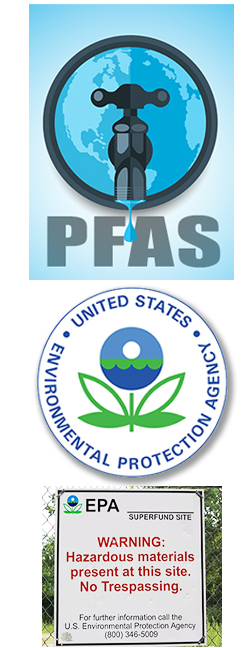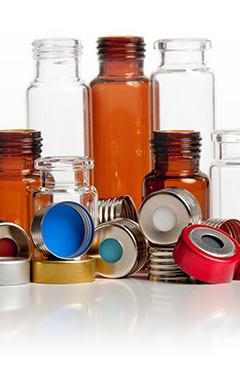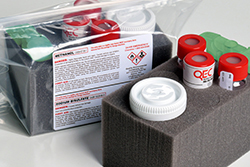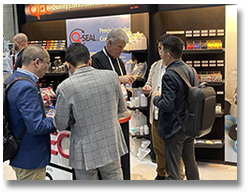 Spring • 2024 Spring • 2024 |
In this Issue: |
 |
In two major announcements in April, the US EPA says it will begin enforcing PFAS contaminant limits in community drinking water and at Superfund cleanup sites. On April 10 the EPA issued the first-ever national, legally enforceable drinking water standard for per-and polyfluoroalkyl substances (PFAS), also known as ‘forever chemicals.’ The rule sets limits for five individual PFAS: PFOA, PFOS, PFNA, PFHxS, and HFPO-DA (also known as “GenX Chemicals”). The rule also sets a limit for mixtures of any two or more of four PFAS: PFNA, PFHxS, PFBS, and “GenX chemicals.” EPA estimates that about six to ten percent of the 66,000 public drinking water systems subject to this rule may have to take action to reduce PFAS to meet these new standards. All public water systems have three years to complete their initial monitoring for these chemicals. They must inform the public of the level of PFAS measured in their drinking water. Where PFAS is found at levels that exceed these standards, systems must implement solutions to reduce PFAS in their drinking water within five years. The new limits in this rule are achievable using a range of available technologies and approaches including granular activated carbon, reverse osmosis, and ion exchange systems. For example, the Cape Fear Public Utility Authority, serving Wilmington, NC – one of the communities most heavily impacted by PFAS contamination – has effectively deployed a granular activated carbon system to remove PFAS regulated by this rule. Drinking water systems will have flexibility to determine the best solution for their community. PFAS designated as a hazardous substance under Superfund law In an April 19 announcement, the EPA took action to designate two widely used PFAS as hazardous substances under the Superfund law, to facilitate accountability and clean-up of PFAS contamination in communities. This final rule will designate two widely used PFAS chemicals, perfluorooctanoic acid (PFOA) and perfluorooctanesulfonic acid (PFOS), as hazardous substances under the Comprehensive Environmental Response, Compensation, and Liability Act (CERCLA), also known as Superfund. EPA is taking this step to designate PFOA and PFOS under CERCLA because both chemicals meet the statutory criteria for designation as hazardous substances. Under the rule, entities are required to immediately report releases of PFOA and PFOS that meet or exceed the reportable quantity of one pound within a 24-hour period to the National Response Center, State, Tribal, and local emergency responders. The designation of PFOA and PFOS as hazardous substances under CERCLA enables the agency to use one of its strongest enforcement tools to compel polluters to pay for or conduct investigations and cleanup, rather than taxpayers. Designation is especially important as delay in addressing contamination allows PFOA and PFOS more time to migrate in water and soil, worsening existing contamination. Read more about the CERCLA final rule here. https://epa.gov/superfund/designation-perfluorooctanoic-acid-pfoa-andperfluorooctanesulfonicacid-pfos-cercla Read EPA’s CERCLA Enforcement Discretion Policy here. https://epa.gov/enforcement/pfas-enforcement-discretion-andsettlementpolicy-under-cercla Read more about EPA’s strategy to address PFAS here. https://epa.gov/pfas Read more about EPA’s Superfund program here. https://epa.gov/superfund Read more about the Superfund Enforcement Program here. https://epa.gov/enforcement/superfund-enforcement Source: United States Environmental Protection Agency |
 |
Metrics for selecting headpace vials, closures Headspace gas chromatography analysis is a method commonly used with volatile organic compounds in environmental analyses, biochemistry, and pharmaceuticals. On occasions when the analytes to be examined are in a complex sample mixture, but the analytes are more volatile than the matrix, the analytes of interest can be isolated in the gaseous (headspace) portion of the sample vial. Headspace vials and caps must be able to withstand temperature extremes as well as the pressure buildup of the gas in the vial. Selection of the right components depends on a number of factors. Here are a few to consider: Radius (round) bottom or flat bottom? Is Beveled Better? Screw-top or crimp-top closures? QEC has an excellent selection of headspace vials, closures and septa to work with most autosamplers. For information and corporate pricing options, contact QEC’s customer service team. |
 |
New sampler added to QEC Method 5035 kits All QEC soil sampling kits, our standard as well as custom configurations, now include the 5g/10g Combo Core sampler which was featured in our Winter 2024 newsletter (click here. to read the article). QEC offers a Standard High and Low Level Sampling Kit, a Standard High Level Only Sampling Kit, plus more than 30 custom kit configurations to fit many specialized soil sampling needs. Every kit is available in packs to cover 6 or 16 sample points. Each kit includes the Combo Core® Sampler, a dry weight container with lid, the appropriate combination of preserved 40mL VOA vials, detailed instructions, and SDS sheets. QEC can custom build 5035 kits to meet your exact needs and your budget. Contact QEC's customer service team for complete information and pricing options. |
|
|
Pittcon wrap-up and on to Texas and Florida For nearly every one of its 30 years in business, QEC has exhibited at Pittcon, one of the world's largest conferences and expositions for the analytical sciences. Thank you to the hundreds of visitors to our exhibit for making this one of our most productive appearances ever. In May we will be at the renowned Texas Commission on Environmental Quality (TCEQ) Expo, and following that is our annual visit to the Florida Society for Environmental Analysts Spring Conference. Hope to see you at least one of these events. |
|
|
Raising less greenhouse-gassy cows A Curtin University study has revealed breeding less-flatulent cows and restoring agricultural land could significantly reduce rising methane emission levels, which play a considerable role in climate change. The food system, including grazing animals such as cows, generates major sources of methane mainly due to cattle digestion, manure decomposition, and land use for grazing. To look for solutions, researchers from the Curtin University Sustainability Policy Institute analyzed 27 academic publications and identified dozens of potential strategies to reduce methane emissions from Australia’s beef and dairy sectors. Studies have found low emission cattle have inheritable genetic traits which can significantly reduce methane production if included in national breeding objectives. While more research is needed to identify the best traits for low emission cows, consideration should also be given to land use emissions and identifying suitable agricultural land for restoration to natural habitat, according to the study. Other strategies to emerge from the study include finding ways for cows to reach maturity faster, improving wastewater management at beef processing plants and providing ozonated water (water treated with ozone gas to remove impurities), feeding cattle more grains than grass, and adding certain legumes, seaweeds or other compounds to cattle feed. Source: Lab Manager News |
| E | © 2024 | Quality Environmental Containers, Inc. |



